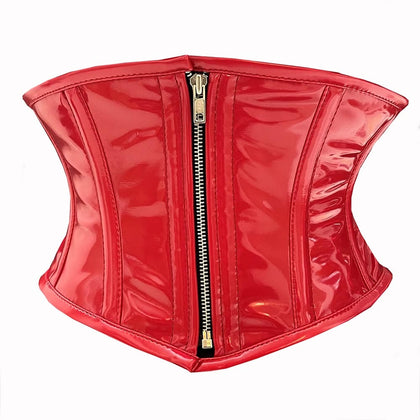

Corsets have been around for centuries and are well-known for giving the body a slimmer, more defined shape. Today, people use corsets for various reasons, including fashion, posture support, and waist reduction. Some people wear corsets occasionally for special events to achieve an instant slimming effect, while others practice waist training for long-term changes. Both approaches Provide different results.
One of the most common questions people ask is: How many inches should a corset take off? This is an important question, especially if you're planning to wear a corset for waist training or to enhance your look. Let’s take a closer look at how corsets work to reduce your waist.
How Do Corsets reduce your waist?
Before discussing how many inches you can expect to lose, it's important to understand how a corset works. A corset is designed to compress your waist and reshape your torso by pulling in your midsection. It’s typically made with sturdy materials like steel boning or plastic to ensure a strong hold.
When you wear a corset, it applies pressure to your waist area, making your waist look smaller. However, it's important to note that there are both short-term and long-term effects of wearing a corset:
Short-term: When you first put on a corset, it will instantly make your waist smaller. This is temporary, and once you take off the corset, your waist will return to its normal size. Typically, wearing a corset can reduce your waist by 2 to 4 inches. This depends on a few factors, including the type of corset you're wearing and how tightly you lace it.
Long-term: If you wear a corset regularly over time (a practice called waist training), it may gradually reshape your body, leading to more permanent waist reduction. However, this requires consistent wear over weeks or months. With dedicated waist training, some people can reduce their waist size by 4 to 6 inches or more.
Factors That Determine How Many Inches a Corset Can Take Off
There is no universal answer to how many inches a corset can take off because it varies from person to person. Several factors come into play, including:
1. Body Type and Shape
Your body shape plays a significant role in how many inches you can reduce. People with different body shapes will experience different results when wearing a corset.
- Hourglass-shaped bodies tend to get the best results since they already have a naturally defined waist.
- Apple-shaped bodies may not see as much waist reduction since they tend to carry more weight around the midsection.
- Pear-shaped bodies may also find that their hips and bust are more prominent, which could limit how much their waist can be compressed.
Each body shape reacts differently to corsets, so the results are unique to each person.
Read More: How To choose the corsets According to your Body type?
2. Corset Sizing and Fit
Choosing the right size corset is crucial for achieving the best results. If your corset is too big, you won’t get much waist reduction. On the other hand, if it’s too small, you’ll feel uncomfortable, and it could be harmful.
A general rule of thumb is to choose a corset that is about 4 to 6 inches smaller than your natural waist size. This allows for some compression without being too tight. For example, if your natural waist is 30 inches, you might want to choose a corset that has a waist size of 24 to 26 inches.
Checkout our Comfortable Modern Corsets
3. Experience with Corsetry
If you’re new to wearing corsets, you should expect to lose fewer inches at first. Over time, as your body gets used to the corset and you learn how to lace it properly, you may be able to reduce your waist by more inches.
Experienced corset wearers can often achieve greater waist reduction because they know how to lace the corset more effectively and have trained their bodies to adapt.
4. Corset Material and Quality
The material and quality of the corset also play a big role in how much you can reduce your waist. Steel-boned corsets are the most effective at waist reduction because they are sturdy and offer firm support. Plastic-boned corsets, while cheaper, don’t offer as much compression and may not last as long.
If you’re serious about waist reduction, it’s worth investing in a high-quality steel-boned corset that can give you the best results.
Further Readings: Waist Trainers
- The Art of Safe and Effective Waist Training
- The Ultimate Guide to Long Torso Waist Trainers
- Waist Corset Trainers: Achieve a Slimmer Waist Fast
- Waist training for long torso: Expert-Approved Tips
- when is the best time to wear a waist trainer?
- What is Corset Stealthing? Tips & Wardrobe Ideas
Is It Safe to Reduce Your Waist by Several Inches?
While the idea of reducing your waist size by several inches sounds appealing, safety should always be your top priority. Corsets, when worn correctly, are generally safe, but there are risks involved if they are worn improperly or too tightly. Here’s what you need to know to ensure you’re wearing your corset safely.
Tight Enough, But Not Too Tight
A corset should fit snugly around your waist, but it shouldn’t cause you pain or make it difficult to breathe. If you’re lacing your corset too tightly, you may experience discomfort, difficulty breathing, or even harm to your internal organs. The goal is to achieve a balance between shaping your waist and maintaining your comfort and health. If you feel pain or pressure, it's a sign that the corset is too tight.
Health Considerations
Wearing a corset for long periods or lacing it too tightly can lead to health issues, such as restricted breathing, digestion problems, or back pain. To stay safe, start slowly by wearing the corset for short periods and gradually increasing the time you spend in it. It’s also important to give your body breaks and not wear the corset every day if possible. Listening to your body is the key to safe corset use.
Further Readings
→ Corsets 101: A Beginner's Guide, Everything About Corsets
→ How to buy a corset: Tips and Tricks for First Time Buyers
→ How to wear a corset for the first time? A complete guide
Expert Opinions on Waist Reduction and Corsetry
Experts from the medical and fashion worlds have differing opinions on waist reduction through corsets. It’s important to weigh these views when deciding whether waist training is right for you. Let’s see what both sides have to say about corsetry.
Medical Perspectives
Many healthcare professionals urge caution when it comes to waist training. While wearing a corset occasionally for fashion purposes is usually fine, wearing it too tightly or for long periods can result in serious health risks. Doctors often recommend moderation and emphasize the importance of proper fit and comfort.
Fashion and Styling Advice
On the other hand, fashion experts appreciate corsets for their ability to create an hourglass figure and elevate an outfit. They encourage their use for special events or styling purposes but warn against wearing them too tightly or for extended periods. Fashion stylists suggest wearing corsets for shorter durations, allowing you to enjoy their flattering effects without putting your health at risk.
Maximizing Your Waist Reduction: Tips and Tricks
If you're serious about reducing your waist size with a corset, there are some ways to maximize your results. Here are a few tips to help you make the most of your waist training journey.
1. Pick the Right Corset
Choosing the right corset is key. Make sure it fits well and is made from high-quality materials, such as steel-boned corsets, for effective waist reduction. A poorly fitted corset won’t provide the desired results and may even cause discomfort.
2. Take It Slow
Waist training is not a sprint. Start by wearing your corset for short periods and slowly increase the time as your body adjusts. Rushing the process can lead to discomfort and potential health risks.
3. Maintain a Healthy Lifestyle
Corsets can help shape your body, but combining waist training with a healthy diet and regular exercise will maximize your results. Focus on a balanced lifestyle to enhance your waist training progress.
Further Readings: Corset Benefits and Misconceptions
- Are corsets sexualized: Myth vs. Reality
- Benefits of corsets: Emotional, Social, and Physical
- Corsets and Health: Exploring the Surprising Benefits
- Pros and Cons of Corset Waist Training: Everything You Need to Know
- The psychology of corset-wearing: why do people enjoy it?
Final Words: How Many Inches Should a Corset Take Off?
The answer to how many inches a corset should take off depends on a variety of factors, including your body type, the type of corset you choose, and whether you’re looking for an immediate or long-term reduction. For most people, an instant waist reduction of 2-4 inches is typical, while long-term waist training can lead to reductions of up to 6 inches with time and dedication.
While corsets can certainly help you achieve a more defined waist, it’s important to prioritize safety and comfort. Remember to choose the right corset for your needs, take the process slow, and always listen to your body to avoid potential risks.
Corsetry can be a fun and stylish way to enhance your figure, but it’s essential to use it responsibly and with realistic expectations. Whether you're waist training or just wearing a corset for special occasions, the most important thing is feeling confident and comfortable in your own skin.
Common Questions About Corset Waist Reduction
Corsets are often surrounded by myths and misconceptions. Here are some of the most frequently asked questions about waist reduction, along with straightforward answers to help clear things up.
Can Anyone Wear a Corset for Waist Reduction?
Most people can wear a corset safely, but there are certain groups that should be cautious. Pregnant women, individuals with certain medical conditions, and those recovering from surgery should avoid corseting. If you’re unsure whether wearing a corset is safe for you, it’s always best to consult with a healthcare professional.
How Long Does It Take to See Results from Waist Training?
The timeline for results varies from person to person, but you can typically expect to see some changes within a few months of consistent waist training. However, it may take six months to a year to see substantial results. It's crucial to be patient and allow your body the necessary time to adapt.
Is There a Difference Between a Waist Trainer and a Corset?
Yes, there is. A waist trainer is made of more flexible materials like latex and is often used during exercise or for daily wear. It provides a more comfortable fit but may not deliver the same dramatic shaping as a steel-boned corset. If you’re aiming for a long-term, significant waist reduction, a corset is the better option.



